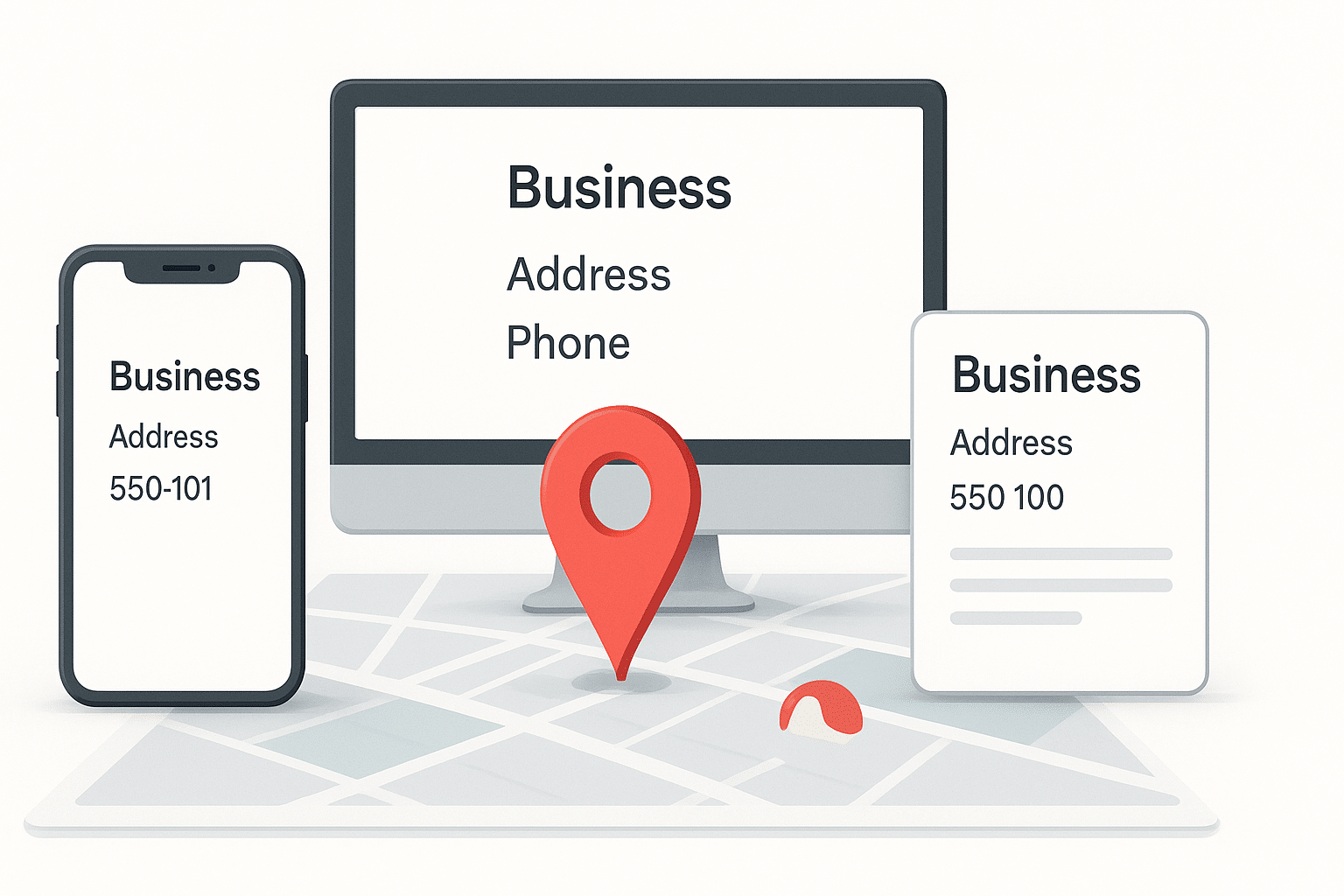NAP consistency (Name, Address, Phone number consistency) is a core idea in local SEO. It means a business shows the same name, address, and phone number across all online listings, directories, and platforms. Search engines rely on this uniform data to verify the business is real and trustworthy.
Even small differences—like a missing suite number or a different phone format—can confuse Google, lower local rankings, and reduce customer trust. Keeping NAP details exactly the same on every website helps boost local search visibility, strengthens citations, and improves click-throughs from maps and directories. In local marketing, it is a basic but vital step.
Why NAP consistency matters for local SEO
NAP consistency plays a key role in local SEO. It helps search engines trust a business listing and makes it easier for people to find correct contact details, improving both search visibility and customer confidence.
Role in search engine visibility
Search engines treat NAP consistency as a trust signal. When a business’s name, address, and phone number appear the same across websites, it helps confirm the data is correct. This increases the chances of ranking in Google’s Local Pack and other local search results.
According to the Moz Local Search Ranking Factors, citation signals—which include matching NAP details—rank among the top five factors for local SEO. Repeating the same NAP on trusted platforms improves confidence in the listing.
Effect of inconsistent listings
When different sites show different phone numbers or addresses for the same business, search engines may treat those entries as unreliable. This reduces the business’s credibility and can lead to:
- Lower rankings in local search
- Removal from map-based listings
- Missed calls or visits due to wrong contact info
Inaccurate NAP data can also confuse customers. For example, if a person sees one phone number on Google and a different one on Yelp, they may wonder if the business is closed or not legitimate.
Impact on customer trust
Studies show that small mistakes in contact information can cause real-world problems:
- 93% of users said they feel frustrated when online listings are wrong
- 80% said they would lose trust in a business after finding incorrect contact details
Even a minor mismatch can drive potential customers to competitors or cause them to give up entirely.
What causes NAP inconsistency in local listings

NAP inconsistency happens when a business’s name, address, or phone number is listed differently across websites. It usually comes from outdated details, typos, duplicates, or tracking numbers, all of which can confuse search engines and customers.
Outdated or changed business details
NAP inconsistency often begins when a business updates its details—such as moving to a new location or changing a phone number—but does not make those changes on every platform. Listings that still show the old address or contact number create a mismatch.
Typos and formatting differences
Small mistakes also create problems. A misspelled street name, a missing suite number, or a digit typed wrong in the phone number can result in different versions of NAP online. Even these small errors, when copied by data aggregators, can spread across multiple directories.
Duplicate listings and unclaimed profiles
In some cases, businesses unknowingly create duplicate listings on the same or different directories. These copies might each have slight differences in NAP data, which makes it harder for search engines to decide which version is correct.
Old or unclaimed business profiles also lead to errors. If a company does not manage its listing, outdated or user-submitted data may stay live for years.
Call tracking numbers
Many businesses use call tracking in their ads. This involves using different phone numbers to track which platform brings in calls. But if each tracking number appears on separate online listings, it creates confusion. SEO experts recommend:
- Using one tracking number as the main business line
- Using dynamic number insertion on websites only
- Avoiding different numbers in public listings unless inside Google Business Profile
Google’s tolerance for small variations
Google can usually read past minor formatting changes. For example, it treats 123 Main Street and 123 Main St. as the same. It also reads both (555) 123-4567 and 555-123-4567 correctly.
Google can match:
- Common abbreviations
- Minor spelling differences
- Standard punctuation changes
What it does not ignore are major changes—like two different phone numbers or listings showing both an old and new address. These are treated as real conflicts and can hurt local search visibility.
User experience and consistency
While Google may forgive small mismatches, people reading listings may not. A person who sees different addresses or contact numbers might get confused or lose trust. That is why keeping all NAP elements the same—across every site—remains important for both SEO and customer confidence.
How to keep NAP consistency across all platforms
Maintaining NAP consistency means keeping your business name, address, and phone number the same across all listings. It requires regular checks, updates, and smart use of tools to avoid errors that can affect search rankings and customer trust.
Audit and monitoring process
Keeping NAP consistency across websites is an ongoing task. The first step is usually a NAP audit, where a business checks all existing listings to find outdated or incorrect details. This can be done manually by searching each site or with local SEO tools that scan and report mismatches.
Tools like BrightLocal, Moz Local, and Yext help locate inconsistencies by comparing a business’s name, address, and phone number across major directories. Some platforms even assign a consistency score to show how uniform the listings are.
Focus on key platforms
Experts suggest starting with the most visible and influential listings, such as:- Google Business Profile , Apple Maps , Bing Places , Yelp , Facebook
These profiles often feed data to smaller sites. Google Business Profile, in particular, is considered the most trusted source. Businesses are advised to verify and correct every detail there first. That exact version should then be used to update other listings.
Using aggregators and APIs
In many countries, data aggregators send business information to directories and apps. In the U.S., common aggregators include:- Factual , Data Axle (formerly Infogroup) , Neustar Localeze
Correcting NAP data in these databases helps spread accurate listings across many smaller sites. Businesses can submit directly or use listing management tools that automate this process.
Ongoing maintenance
NAP consistency is not a one-time task. Business details may change, and third-party sites can introduce errors. To prevent this:
- Review listings every few months
- Re-check after major changes like a move or new phone number
- Watch for user edits or old data resurfacing
Staying proactive helps prevent issues from spreading and supports both search engine credibility and a smoother customer experience.
References
- https://www.brightlocal.com/learn/local-citations/nap-data-accuracy/what-is-nap/
- https://www.callrail.com/blog/nap-consistency
- https://www.brightlocal.com/research/local-citations-trust-report/
- https://www.thirdmarblemarketing.com/nap-consistency-a-simple-way-to-help-you-outrank-local-competitors
- https://www.yext.com/blog/2022/08/nap-seo


